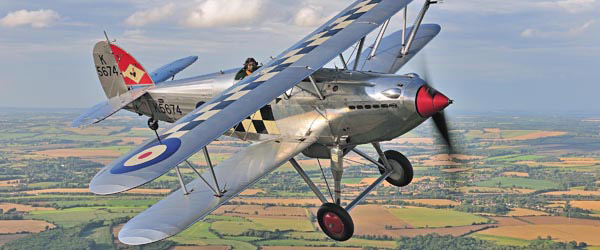
Some of the handsomest biplanes ever built were British and U.S. end-of-an-era fighters of the 1930s. Gloster Gladiators, Curtiss P-6E Hawks, Bristol Bulldogs, Boeing P-12/F4Bs, the fat-bellied Grumman F3F…but the handsomest of all was the shiny, sharp-nosed Hawker Fury, an open-cockpit biplane that pushed the struts-and-fabric limits hard enough to become the RAF’s first airplane able to exceed 200 mph (207 was its top speed) in level flight. Not many were made—a total of 263 Mk. Is and IIs—and only one has survived. Gerald Yagen’s Military Aviation Museum, in Virginia Beach, Va., has a Fury replica that last flew in 2003, but the world’s only real Fury biplane proudly took to the air in Britain last July after a painstaking restoration that probably should be called a reconstruction.
The Fury is owned by the Historic Aircraft Collection, which displays most of its airplanes, including the Fury, at the Imperial War Museum in Cambridgeshire. HAC’s sister company, Retrotec, did the rebuild. Much of the manufacturing of the Furies (and other interwar Hawker biplanes such as the Demon and Hind) was accomplished with archaic devices that no longer exist, so Retrotec had to build not only a biplane but some of the machine tools that originally created it. Much of the metal in the donor Fury’s fuselage, scrapped in South Africa in the early 1940s, had terminally corroded and needed to be remanufactured. Unlike typical steel-tube airplanes, the Fury’s tubes were not welded but mechanically fastened through squared tubing ends and complex joining plates (facilitating maintenance and repair in remote corners of the British empire, where welding torches were rare).
Like the original Furies, Retrotec’s restoration is powered by a rare 700-hp Rolls-Royce Kestrel V12, a progenitor of the Merlin. As a bomber interceptor, the Fury was light and efficient enough that its nearly 2,400-feet-per-minute climb could put it at 20,000 feet just 7½ miles from its takeoff point.
The Fury was truly a transitional airplane. Some of its construction derives from the Sopwith fighters of WWI, yet it was also the direct predecessor of the WWII Hawker Hurricane. The Hurricane had a fuselage that was essentially a Fury’s with an enclosed cockpit, though its wing, retractable gear and Merlin engine were all new. While export Furies served with the Iranian air force until 1949, its last combat mission apparently occurred in April 1941, when a squadron of Yugoslav Furies intercepted incoming Messerschmitt Me-109s and -110s. Eleven Furies were quickly massacred; the only Fury victory was scored by a pilot who rammed an Me-110.




